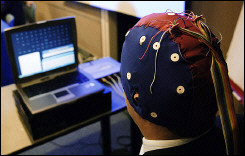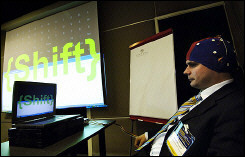June 10, 2006
The New Thinking Cap! It Can Even Type!!!

Brian sent me to an article on Physorg.com that details research to get the computer to respond directly to commands from the mind:
Sitting stone still under a skull cap fitted with a couple dozen electrodes, American scientist Peter Brunner stares at a laptop computer. Without so much as moving a nostril hair, he suddenly begins to compose a message — letter by letter — on a giant screen overhead.
“B-O-N-J-O-U-R” he writes with the power of his mind, much to the amazement of the largely French audience of scientists and curious onlookers gathered at the four-day European Research and Innovation Exhibition in Paris, which opened Thursday.
Brunner and two colleagues from the state-financed Wadsworth Center in Albany, New York were demonstrating a “brain computer interface (BCI),” an astounding technology which digitalizes brain signals emitted as electrical impulses — picked up by the electrodes — to convey intent.
While no spoons were bent, this was definitely mind over matter.

The technology works very slowly, requiring 15 seconds per letter, but for those totally paralyzed, this would provide them a boon in communication:
Dr. Sellers estimates there are some 100 million potential users of BCI technology worldwide, including 16 million sufferers of cerebral palsy, a degenerative brain disease, and at least five million victims of spinal cord injury. Another 10 million people have been totally paralyzed by brainstem strokes, she said….
The Wadsworth system, one of several that detects electroencephalographic (EEG) activity, is based on an algorithm that analyzes the brain waves and identifies peaks in activity that correspond to particular mental efforts. As Dr. Brunner concentrates on the “B” of “bonjour” in a keyboard-like grid of letters and symbols taking up half the screen, a computer randomly highlights lines of characters in rapid succession.
Each time the row — vertical or horizontal — containing the letter “B” is illuminated, Brunner’s brain emits a slightly stronger signal. It takes the computer about 15 seconds to figure out what letter he is looking at. The system is doubly adaptive, with both the software and the person using it becoming more efficient over time.
Truly, this is a pretty cool step in improving a portion of the human condition. It will be interesting to see how this technology evolves.




